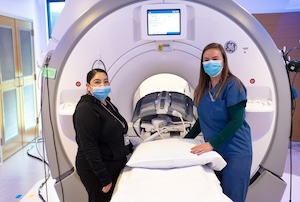Clinical Research and Unique Technologies
Examples of Clinical Applications
For Neurodegenerative Disorders: In Alzheimer's disease, Parkinson's disease, Huntington's disease and Amyotrophic Lateral Sclerosis, MRI in individual and serial scans enables the quantitative assessment of atrophy or disease progression - a transformative leap in diagnosing and tracking these diseases. Additional advances are expected to include the quantification of PET activation and amyloid deposition within specific anatomical regions of interest; and the improvement of individualized risk assessment by combining imaging markers with biofluid markers, cognitive measures, and genetic information.
For Mental Disorders: In Schizophrenia and Bipolar Disorder, CTIPM offers statistical analyses of genome-wide association studies (GWAS); the combination of genetic data with structural and functional imaging data; and mechanistic investigations of the role of specific genes identified by GWAS, in the function and structure of cortical neuronal circuits.
For Cancer: Detection, quantification and multispectral characterizations of primary and metastatic tumors; early detection and quantification of response to therapy; personalized prognostic prediction based on imaging phenotype, quantitative measures of progression, and gene expression measures of tumors or cerebrospinal fluid (CSF); and the validation of the imaging biomarkers in animal models and tissue samples.
For Surgical and Radiation Planning: High-precision multimodal imaging is critical for the accurate targeting of surgical and radiosurgical interventions. CTIPM provides support for a new class of technologies that enable improved detection and targeting of pathology at levels of precision previously unachievable.
Our Technology

The Center for Translational Imaging for Precision Medicine houses a state-of-the-art GE Discovery MR750 3T MRI scanner. This scanner offers high-resolution structural imaging as well as dynamic imaging techniques.
Full access to a pulse sequence-programming environment is available, using the GE's EPIC programming language. The scanner is available for research scanning 24 hours a day, 7 days a week. Scan time is scheduled through a web-based calendar system that is monitored and operated by Center staff.
Driving New Advances in Imaging
Researchers at CTIPM are actively researching new technologies and techniques for medical imaging, post-processing and analysis. For example, a new MRI technique developed by CITPM researchers, known as restriction spectrum imaging-MRI (RSI-MRI), improves physicians' ability to precisely pinpoint a tumor's location, how extensive it is, and even its grade - an indication of how quickly a tumor is likely to grow and spread.
Typically for the imaging of tumors, specialists employ a technique called contrast enhanced MRI. This involves intravenously injecting die into the patient, which flows to blood vessels feeding the tumor. Because blood flow is commonly enhanced in tumors, physicians can distinguish a tumor from healthy tissue because the die in the tumor will reveal its heightened blood flow. However, this technique cannot detect all tumors because the blood flow in some tumors doesn't significantly differ from that in surrounding tissue.
An alternative technique, known as diffusion MRI, measures the diffusion of water in tissue, and therefore the tissue's density (cancer tumors are generally more dense than healthy tissue). But this technique too has limitations: magnetic field artifacts can distort the actual location of tumors by as much as 1.2 centimeters, or about half an inch. That can be significant during delicate surgeries where tumors are adjacent to nerve bundles and other vital tissue.
Enter RSI-MRI. This new technique corrects magnetic field distortions and focus on water diffusion within cancer cells - not just through cancer tissue generally. These two advances allow physicians to more precisely plot a tumor's location, and its boundaries. RSI-MRI has also been found to help physicians predict the grade of tumors - and that means patients can potentially avoid aggressive treatment. Consider prostate cancer, for example: because the disease can be indolent, some patients may only require noninvasive surveillance - rather than aggressive surgery.
